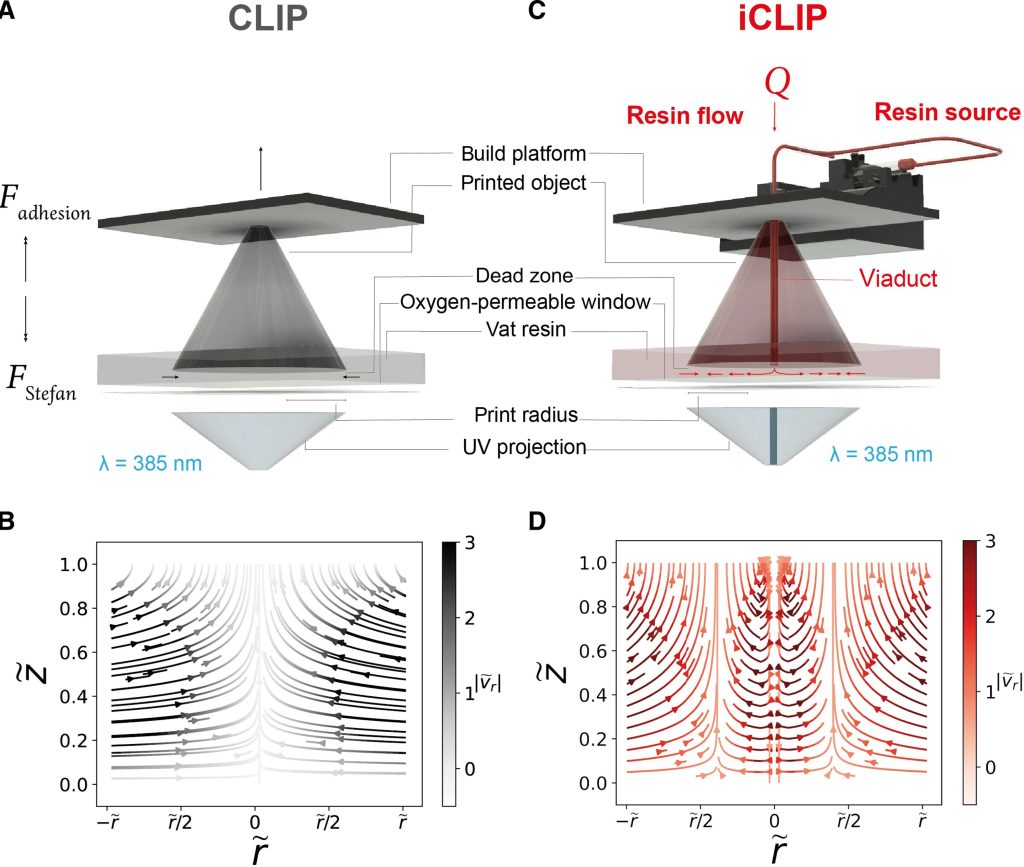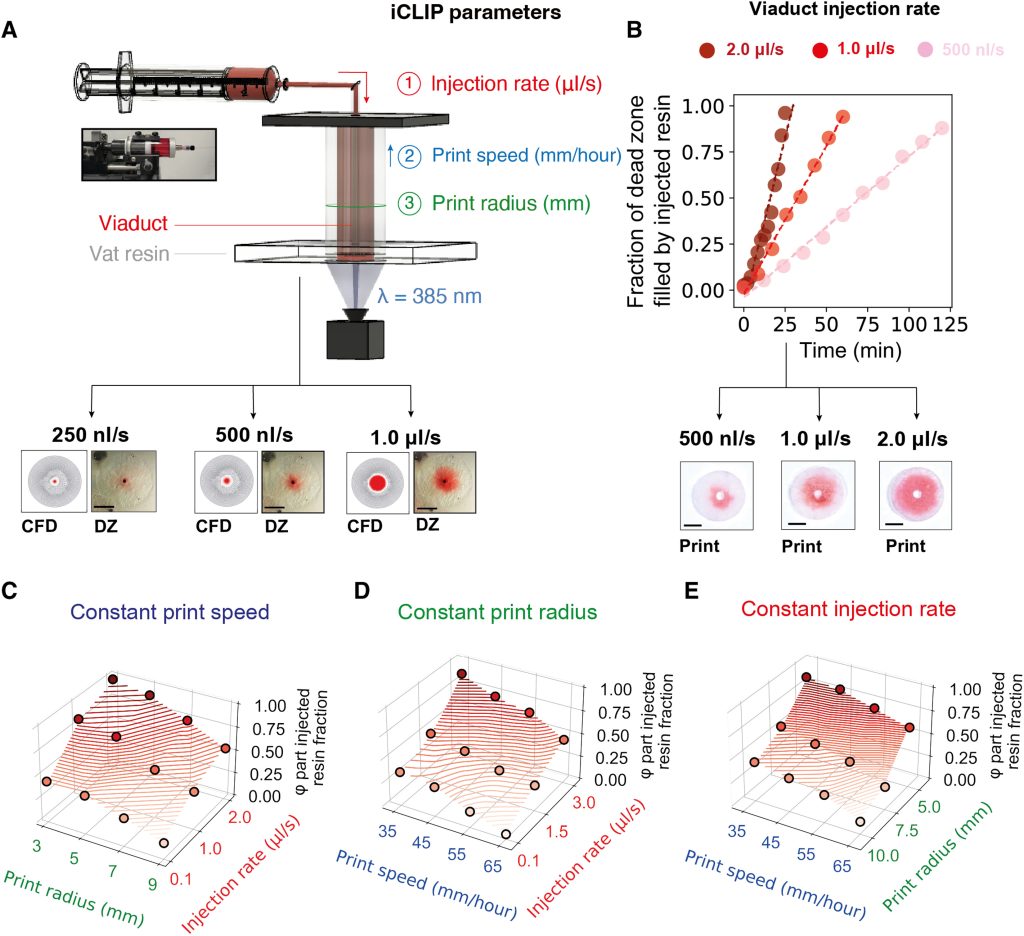Researchers at Stanford University have announced the development of a polymerization process that’s “five to ten times faster” than the current quickest high-resolution resin 3D printers on the market.
Essentially a fresh take on the Continuous Liquid Interface Production (CLIP) method developed by Carbon, the team’s ‘iCLIP’ approach involves repurposing an oxygen-filled ‘dead zone’ at the bottom of a CLIP printer’s resin pool. By pumping extra material into this space, the scientists have managed to accelerate the process, and unlock unique conduit-integrated part designs.
“This new technology will help to fully realize the potential of 3D printing,” says one of the study’s authors and Carbon Co-Founder, Joseph DeSimone. “It will allow us to print much faster, helping to usher in a new era of digital manufacturing, as well as to enable the fabrication of complex, multi-material objects in a single step.”

Better utilizing CLIP’s ‘dead zone’
Co-developed by DeSimone and patented by his firm Carbon when first introduced in 2015, CLIP 3D printing is categorized as a photopolymerization method, but it works slightly differently to SLA or DLP. Instead of printing layer-by-layer, the technology allows for the balance of UV light interactions, in a way that enables objects to be continuously ‘grown’ from a resin pool, via a much faster process.
At the heart of the CLIP approach is a ten-micron-thick dead zone in the resin pool where photopolymerization cannot occur. Above this window, cross-sectional images of a 3D model are effectively projected into the material, hardening it into desired shapes, and as a solidified piece rises, liquid resin is supposed to fill in behind it, allowing for smooth, continuous curing.
However, as the Stanford team point out, this doesn’t always happen, especially if a build rises too quickly, or the resin has a particularly high viscosity. To get around these issues, the researchers have therefore come up with a new approach, in which platform-mounted syringe pumps add resin at key points in the build.
“The resin flow in CLIP is a very passive process – you’re just pulling the object up and hoping that suction can bring material to the area where it’s needed,” explains one of the study’s other co-authors, Gabriel Lipkowitz. “With this new technology, we actively inject resin into the areas of the printer where it’s needed.”

Printing unique multi-material parts
In practice, the additional resin pumped into iCLIP builds is delivered via conduits that are printed simultaneously with part designs. While these can be removed after the object is completed, the Stanford scientists have found that incorporating them into builds, unlocks unique parts with integrated vein-like channels.
By injecting each additional resin separately, the team also theorized that iCLIP would enable the introduction of multiple types of material during the printing process. To test this idea, the researchers fitted a prototype system with three syringes, each filled with a different dye-colored resin, before using it to 3D print tiny test models of famous buildings.
Compared to CLIP-printed builds, these were found to feature fewer defects, as iCLIP eliminated the suction forces that can slow the process down, and draw unwanted resin into the periphery of a machine’s dead zone.
Although the team did see ‘viscous fingering’ during production, an instability caused by interactions between low and high-viscosity resins, they say this can be alleviated via careful syringe positioning. As such, having proven iCLIP’s efficacy, the scientists are now working on a program designed to optimize each part’s fluid distribution network, and accelerate the process further.
“A designer shouldn’t have to understand fluid dynamics to print an object extremely quickly,” concludes Lipkowitz. “We’re trying to create efficient software that can take a part that a designer wants to print and automatically generate not only the distribution network, but also determine the flow rates to administer different resins to achieve a multi-material goal.”
“The ability to make objects with variegated material or mechanical properties is a holy grail of 3D printing.”

Since unveiling CLIP in early-2015, Carbon has gone on to raise more than $200 million in funding to support the technology’s development, and launch a series of CLIP-equipped machines. Earlier this year, Carbon launched its M3 and M3 Max 3D printers, faster, larger systems than their predecessors, designed to address the sectors ranging from automotive to dental.
On a more experimental level, researchers have also continued to iterate upon the company’s approach, with the aim of developing an even faster photopolymerization process. Scientists at the University of Michigan, for instance, came up with a single-exposure 3D printing technology in 2019, which was tipped at the time to be up to 100 times faster than layer-by-layer methods.
The researchers’ findings are detailed in their paper titled “Injection continuous liquid interface production of 3D objects,” which was co-authored by Gabriel Lipkowitz, Tim Samuelsen, Kaiwen Hsiao, Brian Lee, Maria T. Dulay, Ian Coates, Harrison Lin, William Pan, Geoffrey Toth, Lee Tate, Eric S. G. Shaqfeh and Joseph DeSimone.
To stay up to date with the latest 3D printing news, don’t forget to subscribe to the 3D Printing Industry newsletter or follow us on Twitter or liking our page on Facebook.
While you’re here, why not subscribe to our Youtube channel? featuring discussion, debriefs, video shorts and webinar replays.
Are you looking for a job in the additive manufacturing industry? Visit 3D Printing Jobs for a selection of roles in the industry.
Featured image shows one of the researchers’ ‘iCLIP’ 3D printed test models. Photo via William Pan.


